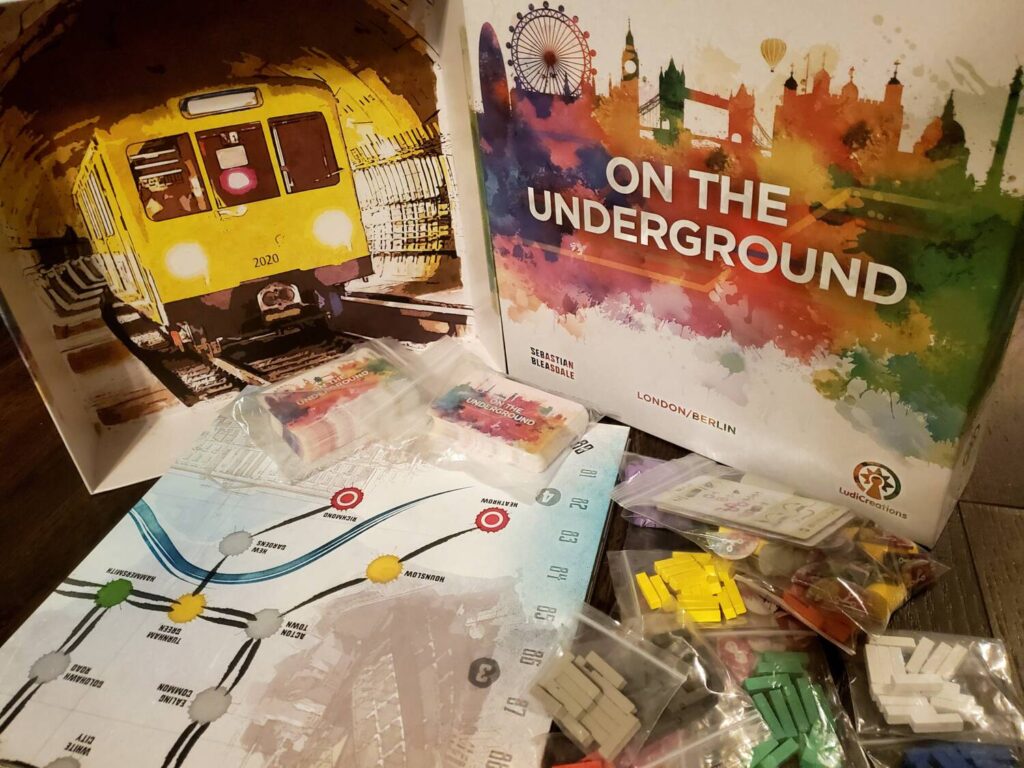Disclosure: Meeple Mountain received a free copy of this product in exchange for an honest, unbiased review. This review is not intended to be an endorsement.
“It’s like Ticket to Ride meets Get On Board meets Caesar’s Empire,” I said to our friends as we sat down to their first play of On the Underground.
I enjoy all three of those titles on one level or another.
The game
On the Underground: London / Berlin dropped in 2019 as a reimplementation of the 2006 original, which was titled without reference to its London locale. The box design is clean and attractive, with splashes of watercolor creating a recognizable London skyline. In a break from convention, the box bottom is the Berlin edition of the graphic, a second cover.

The map is enormous, a two-sided, six-fold behemoth of squares the size of the box. The map holds to that clean, splashed aesthetic, littered with brush-stroked lines connecting various points around the city, which are either plain gray, yellow, or some variety of special. Kudos to LudiCreations for making this thing appealing. Despite the sheer number of dots about, the board is not at all claustrophobic. Some of the brushed lines are doubled and tripled, indicating the possibility of multiple lines passing through.
Players work their way through a deck of locations, using their line colors to create continuous paths around the city in order to accommodate the game’s sole Traveler—a tall and predictably top-heavy meeple. Each player is assigned multiple colors of sticks to lay as track. As the player count increases, the number of lines per player decreases, creating a slightly different experience with different strategies.
A turn consists of spending four actions either laying track or collecting Branch tokens. Track must extend continuously by nature, though a pair of Branch tokens allow for creating a fork in the line. Players can lay any or all of their colors on any given turn as long as they follow the placement rules. At the end of every turn, the Traveler moves to one or two locations according to his preferences: first, to never walk; second, to take the fewest number of lines possible; third, to visit certain destinations first (yellow) if available before landing on the easiest secondary (gray) point. Distance really doesn’t matter. This is all about laziness, wheels over loafers, and the players must oblige. Every line the Traveler uses scores a point.

While the movement points are helpful, the lion’s share of scoring in On the Underground comes from the occasionally-strategic, oft-tactical placement of the lines. Spots around the board score in different ways. Terminus points, mostly around the perimeter, give a nice bonus but introduce branching challenges. Connection points inside the map score a point here and there. Each map creates a unique blend of spots and conditions that the players seek to achieve. All the while, the Traveler moves until the deck runs out and the game ends. Everyone wants the Traveler to move in some sort of recursive loop consisting of only their lines. It is simple enough that my six-year-old has played, but there’s a lot more under the hood than she can understand.
London
London is all about circles. Rather, it is all about some variation of a single circle in the center of the city. If a player completes a loop, each station inside the loop scores a point upon completion. In addition, London features Connection tokens, four pairs depicting attraction types. When a player connects two matching tokens with a single line, bonus points fall like the English rain.
London is considered the starter side of the board. The objectives are approachable and achievable, and the map confines the loops to the center, making the planning far less taxing.

Berlin
Berlin introduces a series of special locations marked in purple. Players attempt to chain these spots together, gathering an increasing bonus for each additional mark in the line. In addition, forty landmark tiles of five different types are scattered about the board randomly in stacks of one, two, and three. Players claim these tokens as lines contact their locations, aiming first to collect sets of all five in exchange for ten instant points. Of course, an alternative strategy beckons from the endgame as players might also/instead choose to collect a pile of a single type, scoring three points each for the type they’ve collected most. This second option might strategically limit the options of other players at the table.

A few thinkings
Before issuing any comparisons, let me say that On the Underground: London / Berlin is a solid blend of aesthetics and mechanics, and I’ve enjoyed it thoroughly. The box and presentation are so very inviting, and the game delivers on that invitation. Turns are simple to explain, but the maps offer engaging considerations, relatively snappy turns, and a Traveler mechanic that brings all eyes back to the table.
From start to finish, the game is interactive. Roughly half the prescribed track lines are shared to some extent—sometimes two, three, four, or even five lines worth. But the other half present single-lane battle lines as players consider ways to scour the map, collect points and anticipate Traveler movement. As players seek to connect or collect tokens, there are occasional races to specific locations, especially as the deck wears down and the end approaches. One reason the board is so enormous, I’m sure, is that the game takes place entirely on the map, not in individual player spaces. Players have their own pile of sticks and a few tokens; but all have an unflapping interest in what’s happening in the center of the table.
Another distinct interaction lingers in the air as players join eyes and noodles to determine the Traveler’s path. The progression is simple enough: least walking, fewest lines. Once the game crosses its midpoint, however, there are typically multiple options that serve the Traveler equally. Players work together to identify the possibilities, and the active player drives it home when there is a choice to be made. I’ve seen comments online citing this as a negative, but I find it to be a charming bit of the game’s inter-personality. On the Underground is time spent together.
The ending can be anticlimactic. There isn’t much of an endgame surge of points, just a steady trickle throughout. Where this could present a runaway leader problem in a mismatch, we’ve found that most of the games are decently competitive. As the final round runs its course, the tight, leapfrog tendencies contain few surprises while offering some great turns. Even over a half-dozen plays we’ve not met with disappointment or discouragement—it screams balance on both sides of the map.

London is definitely simplistic, a great introduction to the system and a sturdy family endeavor. Berlin is more robust with some decisions that can occasionally snake chances out from a neighbor, though a friendly crowd won’t likely dabble much in the nasty that lurks in the design.
I enjoy the fact that each turn begins with a quick calculation of what might happen with the Traveler. This image of the future tucked in the back pocket, the active player then sets out to work. Because players aren’t limited to just one line color per turn, it’s not unusual to attempt to serve two or even three disparate thoughts in a single turn, sometimes directly altering his path, other times ignoring him altogether in pursuit of a lucrative side project. He is a presence, a lazy lure that hooks everyone to pay attention.
A few comparisons
On the Underground: London / Berlin is, in my opinion, a nice step up from Ticket to Ride. I’m quite happy to play a track-layer without the randomness of wading through train cards, and without the dumpster-diving—random and egregious card selection in the hope of unearthing points that have already been earned on the map—that often plagues the end of TtR. I also appreciate managing multiple lines to accomplish goals rather than scattering fragments about en route to artfully producing a unified whole.
I definitely prefer the interactive tension that comes from intentionally building lines out from their ends. While Get on Board forces this movement in one direction from a single origin. On the Underground: London / Berlin offers two open ends and allows for tactical Branches, expanding the breadth of the decision space and allowing for interesting pivots in the name of getting somewhere first.
Caesar’s Empire has been a low-key hit with my family. In part due to the Asterix theme, but mainly for the constant blend of motivations in route building. On the Underground: London / Berlin is a more grown-up version of those motivations. Yes, I want to collect tokens, but I also want to lay pieces in such a way that allows my participation in the Traveler’s decision. I want to connect points on the map, build loops, reach the far ends, and jog my memory turn by turn to remember which travel points might be left in the deck so I can capitalize on my position.
Arriving at the station
On the Underground: London / Berlin works at every player count simply by changing the number of lines players manage. This means the game board reaches a consistent end, but because the distribution of management also shifts, the player counts take on a different feel. I would be happy to sit down, no matter how many people are around.
If you’re a route builder, you’re going to want to try On the Underground. The system makes sense, it looks good, and I really do celebrate it as a game that takes place out there in front of everyone. It plays quicker each time as Traveler movement becomes more intuitive and recognizable. Like the dear Traveler, if you see a line nearby, you should just hop on.












Add Comment